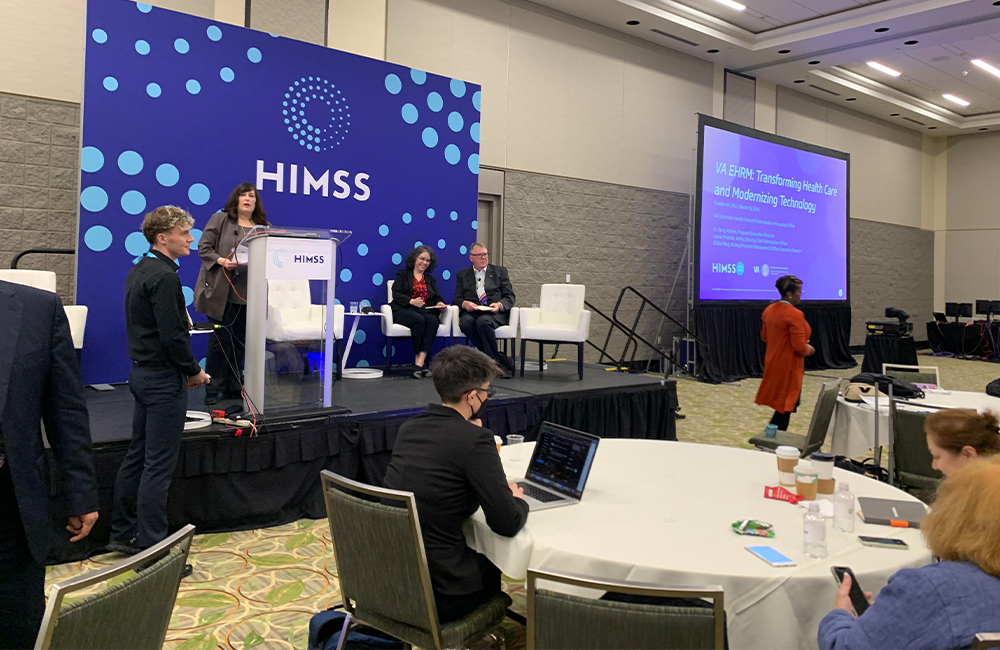VA’s Terry Adirim: EHR is a ‘Challenge and an Opportunity’

The Department of Veterans Affairs (VA) is modernizing workflows, improving data interoperability and bolstering internal and external collaborations to accelerate “clinical transformation” in its Electronic Health Record Modernization (EHRM) Program.
“The new EHR promises to provide a more complete view of veteran care, not just inclusive of military medical records, but also any care received in the private sector,” said Terry Adirim, executive director of VA’s EHR Integration Office, during the HIMSS conference in Orlando, Florida, Wednesday. “Having that complete record is really helpful, especially for the more complex patients.”
VA will focus on building upon VA’s EHR foundation and improving and iterating to rapidly disseminate applications. Adirim said that this could reduce time spent updating the system from months to potentially hours.
The agency will also drive standardized, evidence-based care across the enterprise to develop standard workflows, remove redundancies and provide a uniformed patient experience for veterans. An integral part of these advancements is VA’s IT infrastructure. The agency is modernizing its infrastructure with a focus on interoperability to improve access to patient data.
“I get excited about the fact that this releases our ability for us to access data,” said Dr. Chuck Kowalewski, a physician informaticist from the VA’s functional champion team, at the conference. “I really appreciate the idea of a centralized, structured database that can be shared in interoperability.”
As part of VA’s effort to improve data sharing, the agency is also structuring standards and roadmaps. This guidance will enable VA to better analyze how workflows, technology, infrastructure and language can be brought together to create common workflows.
These modernized workflows will reduce variation across medical centers and systems. By standardizing processes, the agency will be able to create a “transformational system,” said Laura Prietula, acting deputy CIO of VA’s EHR Modernization Integration Office.
“This is an opportunity for us to actually improve and enhance some of the processes we have across the board,” Prietula added. “Not only to normalize and standardize them, but also taking into consideration the culture within our medical centers.”
VA’s new EHR also includes a data analytics tool called the Lights on Network, which processes information activity every night to create data dashboards and usability metrics. The agency is leveraging this tool to reinforce its data-driven approach to modernizing the EHR.
“It’s a very interactive approach,” Kowalewski said. “That’s very helpful at the provider level and of course that helps the veteran in order to get them to be partners in their care.”
As VA continues to roll out and modernize EHRs, the agency said that they’re enacting various cybersecurity measures. Prietula said VA now has a unified cybersecurity group that reviews potential vulnerabilities and develops risk mitigation strategies.
“Together in a federal space, we’re bringing cybersecurity and we’re bringing the risk from our agency’s perspective to a level that we’re both able to address,” Prietula said.
To support IT modernization across the EHR program, VA is developing internal collaborations to drive a unified approach, partnering with the Veterans Health Administration as well as the Office of Information and Technology.
“One of the things that we’ve been changing is working closer with the OIT group,” Prietula said. “We used to be removed from the overall OIT arena … I’m bringing both of them together so that we can be much better together as a team.”
These efforts are “all about the people” to drive clinical transformation, Adirim said. With the recently strengthened Office of the Functional Champion as part of VA’s December 2021 reorganization of the EHR office, Adirim said her unit will be better equipped to deliver care and use the EHR as a tool to improve patient safety, care quality and the veteran experience.
“It’s an opportunity for really how we look at care, how we can do it better, how we can use this tool to improve patient safety, quality and experience. For me, it’s a challenge, but also an opportunity,” Adirim said.
This is a carousel with manually rotating slides. Use Next and Previous buttons to navigate or jump to a slide with the slide dots
-

How TMF is Helping Agencies Accelerate Tech Modernization
The program launched a new AI pilot to expedite TMF applications as agency leaders urge more to consider applying for funds.
4m read -

Defense Board to Pitch Solutions for Closing Tech Talent Gaps
Defense Innovation Board members cite need to modernize people management the same way government modernizes technology.
4m read -

Energy Researchers Aim For Holistic Approach to AI Issues
A new center at the Oak Ridge National Laboratory is looking at under-researched areas of AI to better understand how to secure it.
2m read -

5 Predictions for AI in Government Technology
Agencies are setting plans in motion not only to integrate AI into their enterprises, but also ensuring the data that power these systems are fair.
41m watch




